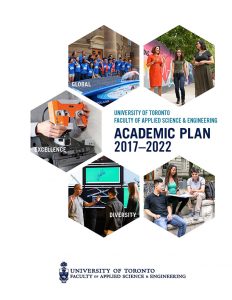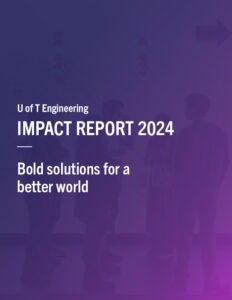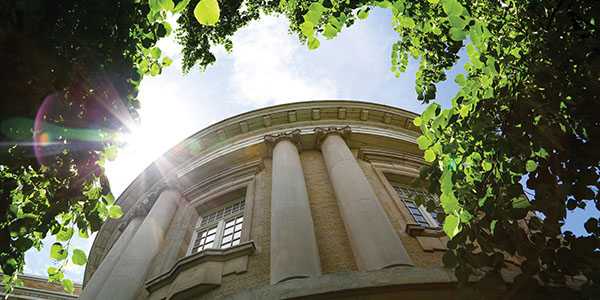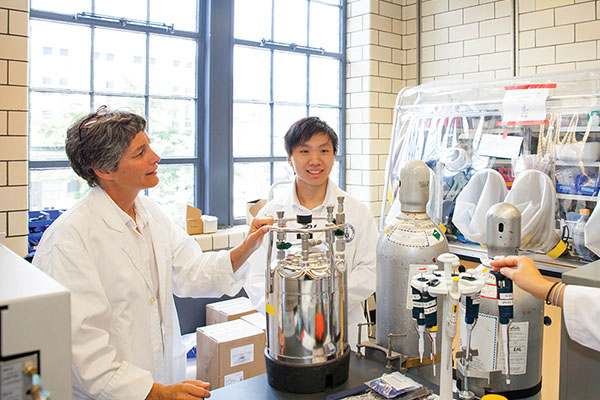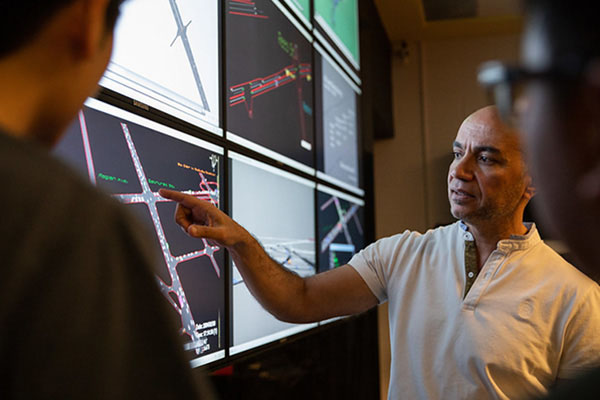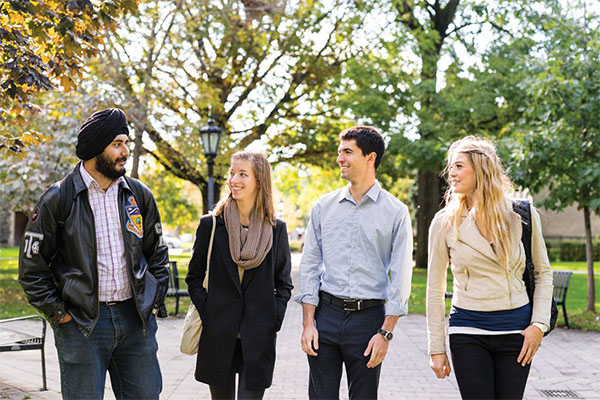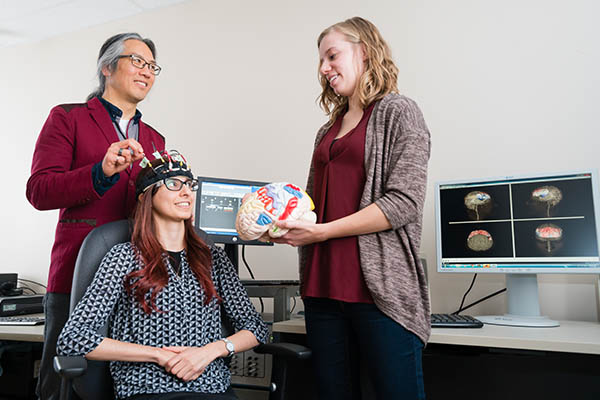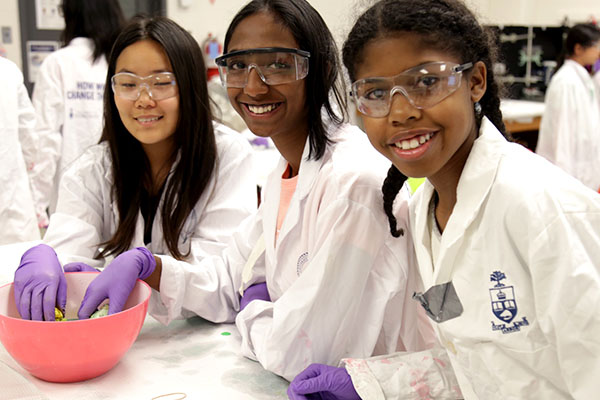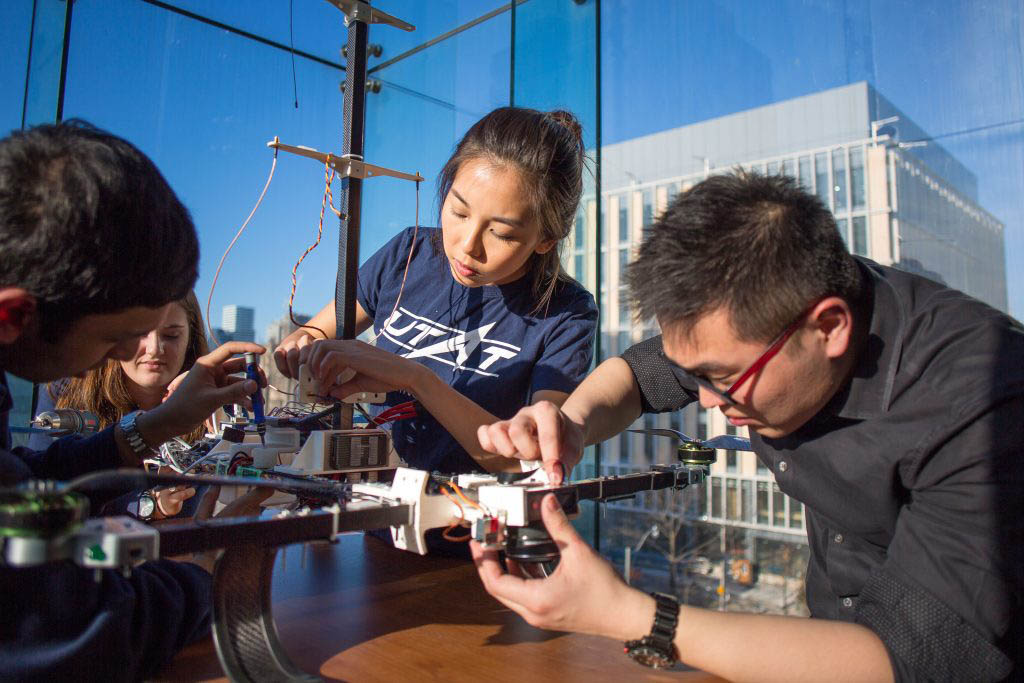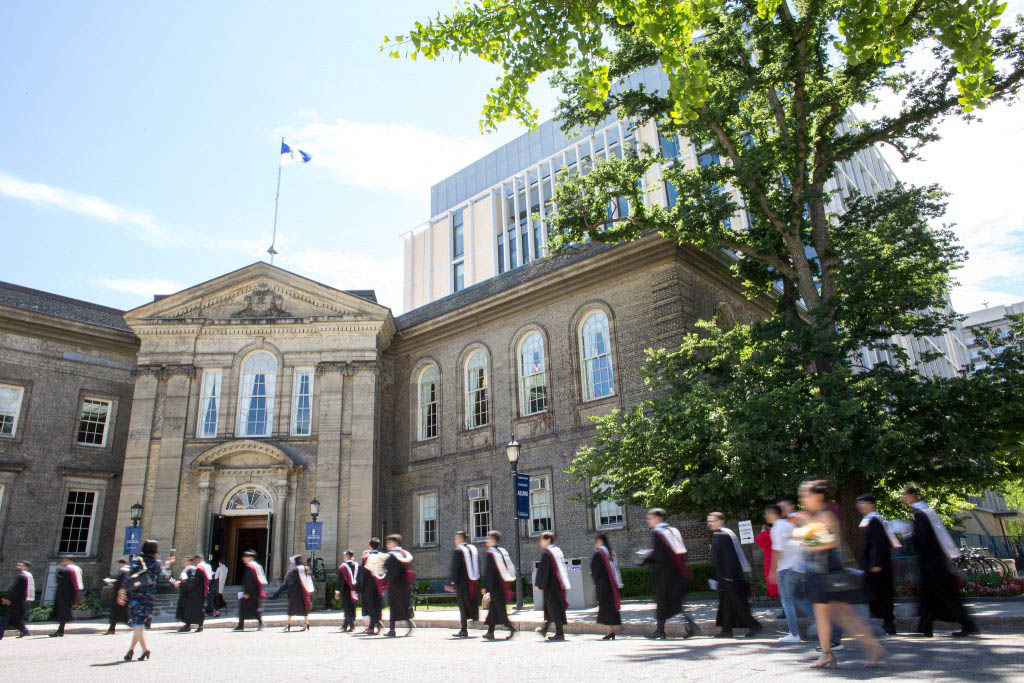The FASE Research Office is pleased to announce the recipients of the 2024-2026 Joint EMHSeed & XSeed Funding Program.
Initiated in 2015, the Joint Seed Program is an interdivisional research funding program designed to promote multi-disciplinary research and catalyze new innovative partnerships between researchers from the Faculty of Applied Science and Engineering and those from outside of Engineering. The recipients for this year will undertake unique and innovative research initiatives ranging from developing bioinoculant strategies to equitable healthcare and advanced imaging techniques.
XSeed Winners
1. Understanding Antibody Responses Through Spatial Analysis
Co-Applicants: Aereas Aung (BME) & Sidhartha Goyal (Physics)
Antibodies are a major outcome of vaccination. However, protective immunity requires high affinity antibodies to tightly bind and neutralize pathogens. Unique to B cells that express these antibodies, they can undergo affinity maturation to adaptively improve the binding affinity of their antibodies to foreign antigens. Tools capable of spatially analyzing antibody properties on B cells have yet to be created, limiting the study of how spatial heterogeneity impacts antibody production. This project will develop an imaging-based platform that melds experimental and theoretical approaches to characterize the binding affinities of antibodies on different cohorts of B cells responding to a vaccine and undergoing affinity maturation. With this technology, Aung and Goyal aim to provide insights that could revolutionize vaccine design, tailoring immune responses for enhanced efficacy against infectious diseases.
2. GPU-Accelerated Radiative General Relativistic Magnetohydrodynamics Toolkit on Cubed-Sphere Meshes for Plasma-Astrophysics
Co-Applicants: Clinton Groth (UTIAS) & Bart Ripperda (Canadian Institute for Theoretical Astrophysics)
Emission from astrophysical systems, like black holes or radiation from the sun, is governed by small-scale interactions between photons and the surrounding plasma. To understand and predict this emission, it is essential to resolve both the large astrophysical scales and the small interaction scale. Due to the nonlinear nature of these interactions, high-accuracy numerical methods are essential to solve this problem. This research project aims to develop a first-of-its-kind radiation magnetohydrodynamics method in strong gravity to study emissions from black holes in the centers of galaxies. Using these proposed methods, Groth and Ripperda will explore similarities between winds and jets from black holes and the sun, and their interaction at large scales with the interstellar medium and Earth’s magnetosphere.
3. Scanning Van Der Waals Microscope (SVM) for Measuring Interlayer Properties Between 2D Materials
Co-Applicants: Tobin Filleter (MIE) & Sergio de la Barrera (Physics)
Two-dimensional (2D) materials like graphene hold great promise as platforms for exploring quantum effects and act as essential building blocks for flexible electronics, novel sensors, and quantum devices. Nearly all applications of 2D materials involve multiple 2D layers to provide stability and environmental isolation. This research collaboration will explore interlayer properties in multilayer structures comprising 2D “van der Waals” materials, like graphene. Barrera and Filleter will design and build a new scanning van der Waals microscope (SVM), that provides increased control over the relative position and orientation of 2D layers and the ability to alter the structure and measure its properties in situ, expanding the field of flexible electronics, quantum devices, sensors, and other related applications.
4. Fearless High-Level Synthesis with Rust
Co-Applicants: Mark Jeffrey (ECE) & Ningning Xie (Computer Science)
The 50-year era of improvement for general-purpose compute is nearing its end. Massively parallel, specialized hardware is the way forward for future performance, but demands inordinate cost and effort. This project aims to empower application developers in productively constructing specialized hardware using cost-effective reconfigurable fabrics. Jeffrey and Xie plan to develop a high-level synthesis (HLS) system based on Rust, a rapidly emerging systems programming language known for its performance, type safety, and fearless concurrency features. This project combines type systems, data race detection, task parallelism, compilers, and semantics design to address the evolving landscape of hardware design and performance optimization.
5. A Dual-Component Biosensor Platform for Quantitative Gastrointestinal Inflammation Monitoring
Co-Applicants: Caitlin Maikawa (BME) & Alana Ogata (Chemical and Physical Sciences / Chemistry)
Inflammatory bowel disease (IBD), a chronic and recurrent inflammation of the gastrointestinal tract, requires regular monitoring to choose correct treatments or prevent recurrence. However, current tests to monitor inflammation in IBD require a visit to a healthcare facility or stool sample collection, which are not suitable or desirable for frequent monitoring. Maikawa and Ogata aim to develop a point-of-care inflammation monitoring technology that is quantitative, administered at home by patients, and does not require stool manipulation which would improve clinician’s ability to monitor changes in gastrointestinal inflammation and enhance patient care. This collaboration aims to develop a new dual-component biosensor platform for disease monitoring that combines an ingestible inflammation-responsive polymer pill with an external biosensor device.
6. Enhancing Sustainable Agriculture: Synergistic Microbial Partners for Growth-Promoting Bio-inoculants in Varied Soil Ecosystem
Co-Applicants: Freeman Lan (BME) & Terrence Bell (Physical and Environmental Sciences)
Bioinoculants are beneficial microorganisms deployed to enhance plant growth and reduce reliance on synthetic fertilizers. Despite their potential, the efficacy of bioinoculants varies significantly across different soil ecosystems due to the challenges in colonizing new environments. This project proposes to develop an advanced bioinoculant strategy by acclimating beneficial microbial strains to diverse soil environments and identifying compatible growth promoting microbial partners through a novel high-throughput microfluidic screening technique. The optimized microbial consortia will then be co-encapsulated in microgels to improve their viability and function in situ. If effective, this approach would offer a robust and ecologically sustainable solution for enhancing crop productivity across a variety of agricultural settings.
7. Autonomous, Scalable and Self-Healing Wireless Sensor Networks for Environmental Monitoring and Just Urban Planning
Co-Applicants: Jorg Liebeherr (ECE) & Scott MacIvor (Biological Sciences)
In cities, the impacts of heat and air pollution are not equally distributed in part due to systemic planning and environmental injustice. Urban greening is a critical tool to buffer these effects, but the ability to monitor environmental variables at a scale relevant to human experience is lacking. This project hopes to lead to a groundbreaking advancement in in-situ environmental monitoring within urban landscapes by developing and deploying self-healing, low-cost, and low-power wireless sensor networks (WSNs). This project will advance this WSN technology for use in long-term urban environmental sensing studies and automate the monitoring of key variables that contribute to the wellbeing of people and nature in a changing climate.
EMHSeed Winners
1. Ultrahigh-Throughput Microfluidics Screening of DNA Damaging Microbial Warheads in the Gut Microbiome
Co-Applicants: Freeman Lan (BME) & William Navarre (Molecular Genetics)
Many intestinal bacteria produce DNA damaging molecules (genotoxins) to outcompete other bacteria in the microbiota. The immense diversity of the gut microbiome makes it difficult to efficiently identify these genotoxin producing strains using traditional methods. This project aims to develop a microfluidic screening method, leveraging the latest advancements in droplet microfluidics technology, to efficiently sift through millions of gut microbes to detect those producing genotoxins. This approach also contributes to personalized medicine by enabling efficient screening of patient microbiomes.
2. Enhancing Closed-Loop Noninvasive Neurostimulation with Neuroimaging and Personalized Whole-Brain Neurophysiological Modelling
Co-Applicants: Milad Lankarany (BME) & John Griffiths (Psychiatry)
Repetitive transcranial magnetic stimulation (rTMS) is an important and rapidly developing therapeutic option for patients with major depressive disorder, addiction, OCD, and several other psychiatric and neurological conditions. However, with remission rates ranging from 40-60%, there is room for improvement in clinical outcomes. Drawing on Lankarany and Griffith’s expertise in these two areas, this project will develop and test a new suite of algorithmic tools designed to enhance rTMS efficacy. This will be achieved by controlling stimulation pulse timing in a manner that is more accurately tuned and responsive to the brain’s own intrinsic rhythmic patterns, as measured by high-density scalp electroencephalography (EEG).
3. Superharmonic Contrast Imaging for Personalized Medicine
Co-Applicants: Naomi Matsuura (MSE/BME) & Christine Demore (Medical Biophysics)
Locally advanced breast cancer (LABC) is a difficult to treat subset of breast cancer with a high risk of recurrence and incurable metastatic disease. Focused ultrasound (FUS) is a non-invasive treatment method that is revolutionizing cancer treatment since it can non-invasively facilitate chemotherapy drug delivery to target tumours in patients. This project combines FUS-compatible, drug-loaded nanobubbles that are designed to increase delivered drug dose while reducing system toxicity, with superharmonic contrast ultrasound imaging, a technique that visualizes nanobubbles within tissue. Matsuura and Demore believe that these specialized ultrasound devices/systems can detect, distinguish, and cavitate nanobubbles in tissue with exquisite sensitivity
4. Medly CHAT: Scaling Heart Failure Remote Patient Management for After Hours Care with an AI Nurse Chatbot
Co-Applicants: Myrtede Alfred (MIE) & Quynh Pham (UHN/Institute of Health Policy, Management and Evaluation)
To support heart failure patients, the Medly program at the University Health Network (UHN) enables remote management to patients who record relevant measures and communicate with their cardiac care team through a Messenger feature. However, patients are not able to chat with their care team after hours. However, Large Language Models (LLMs) can be used to build chatbots that deliver immediate support. This Medly CHAT (Conversational Heart Failure AI Therapeutic) project will apply LLMs to develop a conversational therapeutic in the form of an after hours nurse chatbot that provides real-time guidance to patients and families through Medly Messenger.
5. A Non-Gadolinium Fibrosis-Targeting MRI Contrast Agent
Co-Applicants: Hai-Ling Margaret Cheng (BME) & Filio Billia (Medical Biophysics)
All life-sustaining organs are susceptible to fibrosis, a progressive condition characterized by scarring and contributing to 45% of global deaths. Currently, fibrosis is detected late and is poorly managed, because a diagnosis relies on biopsy, which is ‘too dangerous’ or ‘hit-or-miss’. Validated biomarkers are also lacking for early diagnosis and monitoring and effective interventions are few. To transform patient outcomes in disease states characterized by fibrosis, this project proposes a novel imaging approach for early detection of active fibrosis. Early scar detection is achieved via a new non-gadolinium (Gd) magnetic resonance imaging (MRI) contrast agent that targets collagen, the main component of scar, and safely accumulates at the site of active fibrosis prior to its elimination.
6. Blood-Brain Barrier-on-a-chip for Parkinson’s Disease Modelling and Therapeutic Testing
Co-Applicants: Craig Simmons (MIE) & Lorraine Kalia (Medicine/Laboratory Medicine and Pathobiology)
Parkinson’s disease (PD) is a common degenerative brain condition causing progressive loss of movement control and often cardiovascular complications and dementia. There is no cure for PD, as the mechanisms that underpin the disease are unknown. This gap is due to limitations of the models available to study PD since isolated cells do not capture the complexity of the brain, and animal models do not replicate human disease. This project combines stem cell models of PD and organ-on-a-chip engineering to establish a novel blood-brain barrier model using human induced pluripotent stem cells with genetic mutations that cause PD. The model will capture interactions between blood vessels and neurons in the brain that are thought to contribute to PD progression.
The Engineering Vice Dean Research Office, along with our partner faculties and institutions, would like to congratulate the research teams on their success.

